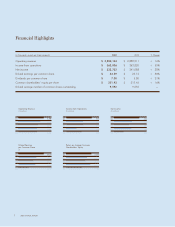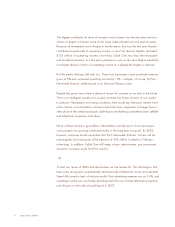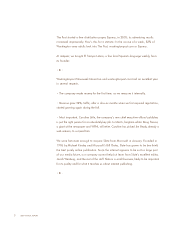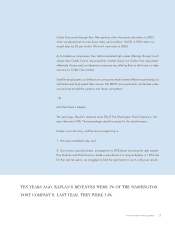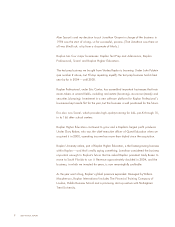Washington Post 2004 Annual Report Download - page 5
Download and view the complete annual report
Please find page 5 of the 2004 Washington Post annual report below. You can navigate through the pages in the report by either clicking on the pages listed below, or by using the keyword search tool below to find specific information within the annual report.
2004 ANNUAL REPORT
3
The biggest contributor (in terms of increase over last year) was the education division,
where we began to harvest some of the many seeds planted over the past ten years.
Because of investments and charges in earlier years, this was the first year Kaplan
contributed significantly to operating income; it won’t be the last. Kaplan recorded
$121 million of operating income, more than Cable One, less than the newspaper
and broadcast divisions. In a few years, perhaps as soon as this year, Kaplan should be
our largest division in terms of operating income (it is already the largest in revenue).
But the media divisions did well, too. These four businesses alone produced revenue
gains of 8% and increased operating income by 17% — helped, of course, by Post–
Newsweek Stations’ performance in an election/Olympics year.
Despite this good news, there is plenty of reason for concern as we look to the future.
There are intelligent people who would minimize the future of each of our media
businesses. Newspapers are losing circulation, they would say; television viewers have
more choices, so local stations are less important; news magazines no longer have a
clear place in the media landscape; cable faces overwhelming competition from satellite
and telephone companies, and others.
None of these doubts is groundless. Nevertheless, we like each of our businesses,
and prospects for growing combined results in the long term are good. (In 2005,
however, everyone should remember that Post–Newsweek Stations’ income will be
meaningfully down because of the absence of $42 million in election/Olympics
advertising. In addition, Cable One will forego a basic rate increase, and announced
newsprint increases could hurt Post results.)
To start our review of 2004 with the business we are named for, The Washington Post
had a very strong year, journalistically and financially. Publisher Bo Jones and president
Steve Hills turned in best-of-industry results: Print advertising revenue was up 5.4%, and
operating income was up sharply, excluding both the cost of early retirement programs
and the gain on the sale of a parking lot in 2003.



